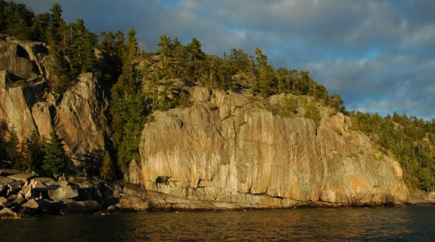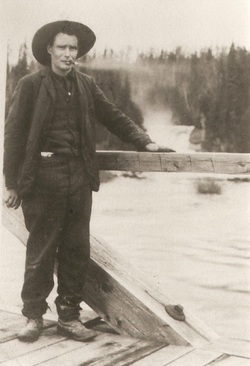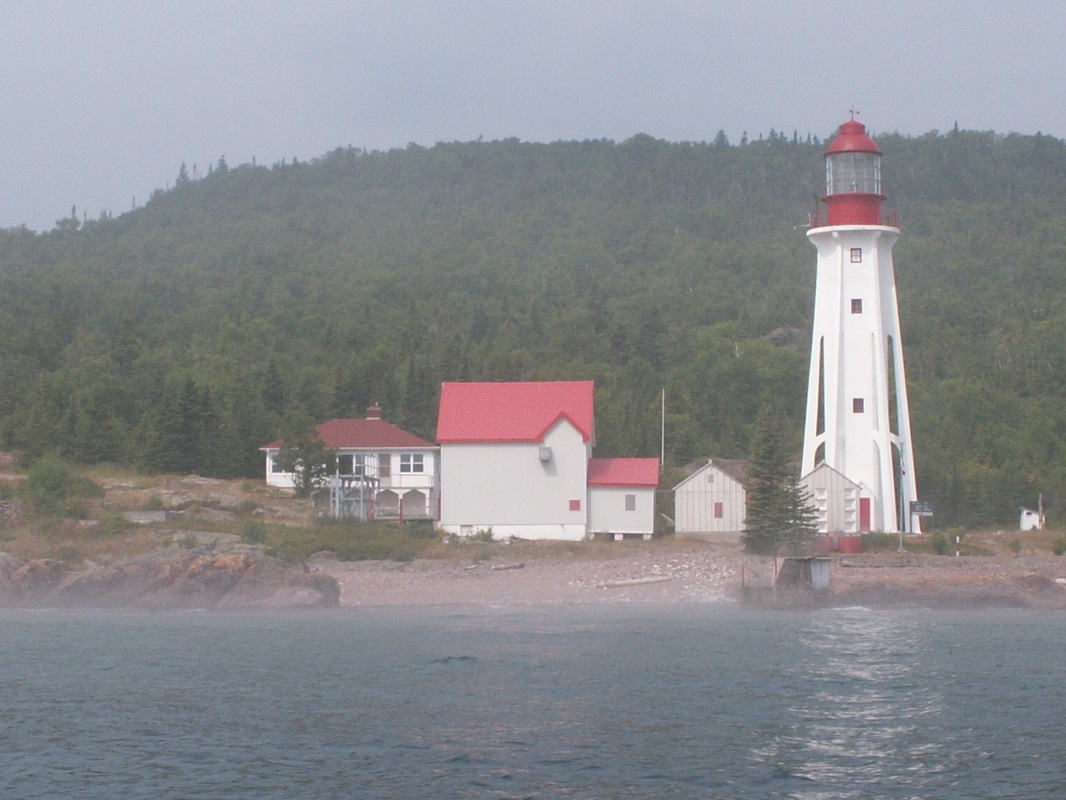Photo Caption: Agawa Rock cliffs - photo provided by J. Cooper
Where can one stand on a 5 foot wide granite ledge with the vast expanse of Lake Superior at your back, unpredictable waves reaching for your feet, and a 70 foot cliff adorned with ancient rock art only inches from your face? This question can be answered by the adventurous tourists who descend the rugged path down to the Agawa Rock Pictograph site today, just as it could have been answered by the Ojibway artists, paddlers and fishermen of the past 300 years.
Agawa Rock is located along some of the most dramatic Superior shoreline 150 kilometres north of Sault Ste. Marie. A granite wall of quartz, the bedrock juts out of the deep, green depths of Superior near the traditional Ojibway summer settlement sites at Agawa Bay and Sinclair Cove. The Rock, as it is affectionately called by the summer students who are stationed at the site to provide interpretive tidbits to tourists, was a natural billboard for Ojibway ancestors to leave messages for future visitors to the site.
The pictographs consist of faded drawings depicting animals, canoes and mythical creatures believed to inhabit the Lake and the surrounding shoreline. The red ochre symbols are scattered along the rock ledge mere feet from the waters edge. They reflect the lives and epic tales of the Ojibway people who have inhabited this dynamic landscape for centuries.
The existence of the Agawa Pictograph site was first documentd by Henry Rowe Schoolcraft in the early 1800’s after he interviewed Chief Shingwaukonce. Schoolcraft did not visit the site, but was given a detailed drawing by Shingwaukonce of the symbols and artwork as he remembered them.
Although Agawa Bay was a regular waypoint for the brigades of fur trade canoes and early European travellers, there are few if any references to the pictograph site included in any of the journals and diaries kept by those who recorded their journeys from Sault Ste. Marie to Michipicoten, Fort William and beyond.
As the Agawa Bay area became more populated by commercial fishermen, lighthouse keepers and tourist operators, the paintings became a backdrop for additional “artwork” added to the site. In 1879, a popular sportsman’s magazine published in New York City made note of the Agawa paintings as part of their regular tour during their annual fishing trips. However this particular year the author stated “Last year, when I passed there, I found the frost scaled great pieces off the rocks, and the best of the pictures are gone forever.”*
In 1944 Lake Superior Provincial Park was established as a response to public concern for the protection and preservation of public land from encroaching development north of Sault Ste. Marie. In 1946 a survey of the park’s assets and resources was conducted yet cultural sites and locations were not included. No mention was made of Agawa Rock or its significance to the character and diverse heritage values in the Park.
In 1958, while conducting a survey of rock art in the Canadian Shield, artist and author Selwyn Dewdney “rediscovered” the Agawa Rock Pictograph site. His passion and knowledge of the traditions and stories behind native rock art highlighted the significance of the Agawa Rock location and brought it to the publics’ attention. After his death in 1979, the Ministry of Natural resources planted two stands of white pine at Agawa Bay to honour his memory. The family also erected a plaque in a shady section of the granite cliff face, only a few metres away from the faded red ochre symbols that fascinated him.
Today the Agawa Rock Pictograph site is one of the most famous pictograph sites in Canada. A paved road and rugged trail lead thousands of travellers each year to its dramatic granite ledge. The adventuresome paddler and fishermen are provided the most authentic view when they access the site from the water. Whether you were once drawn to the site as an Ojibway artist given the honour to leave your mark, or you are a curious traveller exploring the site by foot or canoe, the Agawa Rock Pictograph site is a dramatic piece of our cultural heritage which visitors will continue to appreciate for years to come.
* Forest & Stream – Rod & Gun. Volume 12, Number 10 edition of May 22, 1879, New York, New York.



 RSS Feed
RSS Feed
